Reading a Tire Sidewall
The tire sidewall of your contains important information that tells you everything about your tire regarding the dimensions, construction, operating characteristics and manufacturer. The easiest way to understand tire markings is to take an example and break it down.
For our example, these numbers are:
P225/60R16
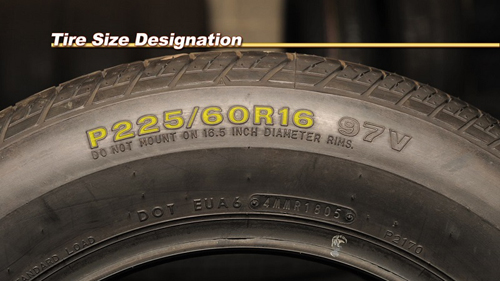
(P) Tire Type
The “P” stand for passenger so these tires are often called P-Metric. Other letters you might see include “LT” for Light Truck, “ST” for Special Trailer and “T” for temporary. The absence of a letter at the beginning of the size description indicates that the tire is Euro-Metric. The main difference is that Euro-Metric tires may have different load carrying capacities than their P-Metric counterparts.
(225) Tire Width
The 225 represents the approximate section width or width of the tire from sidewall to sidewall. The larger the number, the wider the tire.
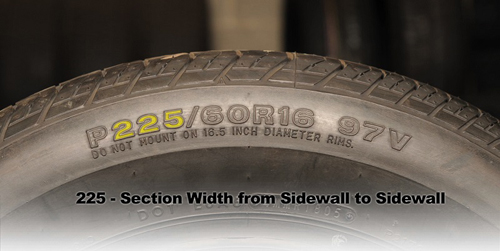
(60) Aspect Ratio
The 60 refers to the aspect ratio, which is the nominal sidewall height reflected as a percentage of section width. So the sidewall height on this tire is 60% of 225 or approximately 135 millimeters.
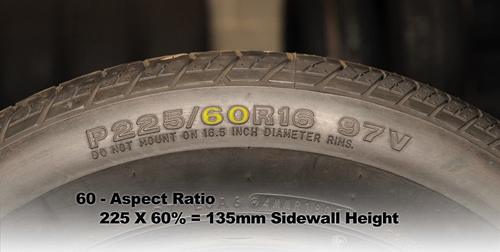
(R) Construction
The “R” stands for radial construction, which is the industry standard for passenger car and light truck tires. A “B”, “X”, or “-” in place of the “R” would indicate that the tire has bias-ply construction.
(16) Rim or Bead Diameter
The “16” represents (in inches) the diameter of the beads, which means that this tire is designed to fit on a rim with a 16-inch diameter.
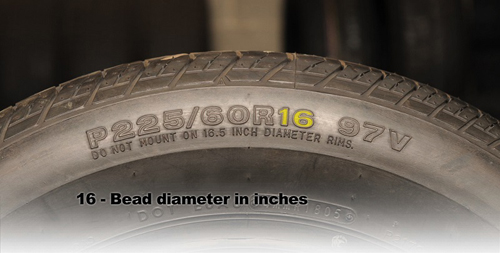
(97V) Service Description
The final component of the size designation is called the Service Description, which indicates the Load Index and the Speed Symbol for the tire. Load Index, or 97 in this example, is a two- or three-digit code that represents the maximum load that can be carried at the speed indicated by the speed symbol. In order to determine the actual maximum load for the tire, you must consult the Load Index Chart below. The Speed Symbol, or V in this example, indicates the maximum speed for the tire, but it is more like a performance rating that reflects the handling characteristics after it is installed on the vehicle. To find the maximum speed for your tire, refer to the Speed Rating Chart below.
DOT Code
Another important piece of information on your tire’s sidewall is often referred to as the Department of Transportation, or DOT, code and the Tire Identification Number, or TIN.
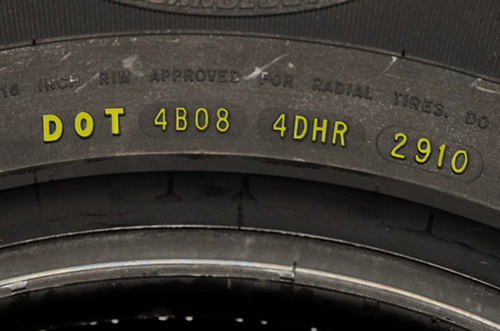
The three letters, “DOT,” indicate that the tire has passed all of the tests required by the Department of Transportation (DOT) for motor vehicle safety standards.
After the DOT insignia is your tire’s identification number (TIN). The first grouping of two to three letters or numbers represents the assigned identification mark for the manufacturer.
The second group can be no more than two symbols and identifies the tire size. The third grouping can be no more than four symbols and may be used at the option of the manufacturer to indicate the tire type or other significant characteristics of the tire. The final four numbers in the TIN represent date of manufacture. The first two numbers reflect the week and the last two indicate the year. So a tire stamped 2910 was manufactured in the 29th week of 2010.
UTQG Code
The Uniform Tire Quality Grading (UTQG) was established by the National Highway Traffic Safety Administration (NHTSA) to test tires following government prescribed test methods and then grade each tire on three main components:
- Treadwear: Treadwear is a comparative figure that attempts to project the longevity of the tire in the form of a three-digit number. This is the wear rate of the tire, comparable only to other tires within a tire manufacturer’s line. It is based on a control tire that is tested under controlled conditions at a specified government test track. The control tire is rated 100. Therefore a tire with 200 would theoretically wear twice as long on the government’s course compared to a tire with 100. Likewise, a tire rated 60 would be projected to wear about 60% as well as the control tire rated 100. Since it is does not take application, driving style or tire maintenance into account, the Treadwear rating cannot project the actual tread mileage of a tire nor can it be accurately used to compare the projected tread life of one brand against another.
- Traction: Traction grades are AA, A, B and C (with AA being the highest grade). They represent the tire’s ability to stop straight in a straight line on wet pavement. Any tire rated under C is considered unacceptable for road travel.
- Temperature: The Temperature grade indicates the resistance to heat and the ratings range from A to C, with A being the most resistant to heat.
Additional Information on Your Tires
Some tires have unique benefits, such as winter tires. These tires have special tread designs and rubber compounds that are engineered to perform better in temperatures below 40 degrees F with or without snow and/or ice. If a tire passes the test requirements for a winter tire, the manufacturer will usually mold a mountain and snowflake icon on the sidewall of the tire to indicate it has been tested to perform in winter conditions.